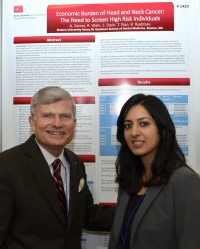Richa Wahi AS 16 Receives IADR Lion Dental Research Award

Richa Wahi AS 16 was the recipient of the International Association for Dental Research (IADR) Lion Dental Research Award at the IADR/AADR (American Association for Dental Research) General Session & Exhibition held at the Hynes Convention Center in Boston, Massachusetts March 11–14, 2015. This prestigious award recognizes junior researchers who are conducting outstanding and innovative research in basic dental science with the goal of improving public oral health.
Dr. Wahi has been working under the mentorship of GSDM Professor and Chair of the Department of Pediatric Dentistry Dr. Athanasios Zavras, along with students from Columbia University, Boris Ryabtsev, Sarah Stein, and Tong Xiao, to calculate the total financial burden of oral cancer on the economy of the United States. The group also evaluated the economic performance of high risk screening for oral cancer. Dr. Wahi was presented this award at the IADR/AADR annual meeting in Boston on Thursday, March 12, 2015. The award was accompanied by a stipend to help continue her research efforts.
In order to calculate the economic burden of head and neck cancer, Dr. Wahi and the other researchers in her group utilized health care expenditure data and patient epidemiology from previous studies, incidence data from the Surveillance, Epidemiology, and End Results (SEER) program, and the American Cancer Society. They also used wage data from the World Bank, a United Nations sponsored financial institution which provides loans to developing countries. The economic burden was calculated for each of the four stages of cancer, and stratified by payer status (private vs. public health sector.) A cost-effectiveness analysis was then performed using a Markov decision model with various cost and utility input values.
The researchers found that the total financial burden for an annual cohort of head and neck cancer patients in the US is estimated at $4.75 billion. In 2014, private payers were responsible for $3.2 billion, while the US government spends an estimated $855 million on head and neck related health care costs. Total dental rehabilitation expenditures are estimated at almost $610 million, and the annual projected loss of wages due to hospital stay is almost $75 million.
The United States Preventive Services Taskforce does not currently recommend routine population screening for head and neck cancers. While data may not exist for the population at large, Dr. Wahi suggests that a more efficient preventative method may be to target those at highest risk and to enroll them in annual screenings. The early detection of cancer greatly improves chances of survival and preserves quality of life. In addition, the group’s research revealed that the no-screening arm in the Markov model was “dominated,” indicating that a nationwide program screening all high-risk individuals in the US is cost-effective. Thus, an annual cancer screening program for high risk individuals would be a beneficial investment to help alleviate the economic burden of head and neck and cancer.
Dr. Zavras was thrilled to have Dr. Wahi’s hard work recognized by the IADR, and hopes that she will continue her research. “As a research assistant, Dr. Wahi has been a major force in moving the research forward,” said Dr. Zavras. “I hope that this achievement will offer her the encouragement and motivation required to consider a full-time academic career devoted to discovery and scientific innovation to improve the public’s oral health.”